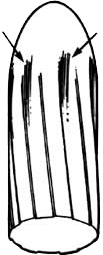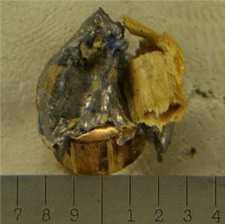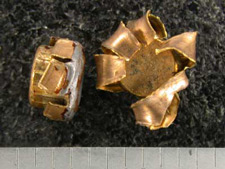Home | Glossary | Resources | Help | Contact Us | Course Map
Archival Notice
This is an archive page that is no longer being updated. It may contain outdated information and links may no longer function as originally intended.
Effects of Firing
Some effects of firing result in microscopic marks of value to the firearm examiner:
- Shaving (shearing) is the cutting of metal from the surface of a bullet due to cylinder misalignment in a revolver. A large amount of shaving may leave a void in the bearing surface of a bullet, which may not receive rifling impressions.
- Skid marks ( slippage ) form on the bearing surface of bullets as they enter the rifling of the barrel before the bullet engages the rifling. Skid marks are typically produced by revolvers and have the appearance of widening the land impressions at the nose of the bullet. Taking measurements in this area should be avoided; base measurements are more accurate.
- Flared bases of bullets fired from short-barreled handguns or bullets with deep base cavities are subject to expansion after leaving the barrel of a firearm. Measuring a flared base would be misleading; the better protected base normally provides the best dimensional data.
- Blowby is the escaping of gases past a fired bullet while the bullet is still in the barrel. These high pressure gases are at a very high temperature and can melt or etch the bearing surface of plain lead bullets. As a result, the width of rifling impressions can be seriously degraded and appear very blurry and indistinct.
- Barrel leading ( metal fouling) is the accumulation of lead or bullet jacket material in the bore of a firearm due to the passage of bullets. This condition may preclude obtaining reliable land and groove dimensions.
- Corroded/rusted barrels occur due to poor care and maintenance and affect bullet bearing surfaces in the same way as metal fouling or leading.
- Lead smears may be deposited on the surface of bullet jackets, obscuring the edges of the land and groove impressions.
These can be removed using a solution containing- 10cc of glacial acetic acid,
- 2cc of 30 percent hydrogen peroxide,
- 70cc of distilled or deionized water.
Impact Damage
Most evidence bullets received in the forensic laboratory have sustained some type of damage associated with impacting the target or object. This damage can range from minimal to mutilated beyond use.
When only a core is recovered (with the jacket separated and/or missing), the core may carry vague suggestions of the rifling impressions from the jacket. Although there will be no measurable dimensional data, the number of land and groove impressions may be observed.
Extreme Damage
Extremely fragmented, distorted, deformed, and mutilated bullets are processed as follows:
- Trace evidence of value is recovered.
- All debris is removed.
- Rifling impressions in undamaged areas are evaluated.
Mushrooming
Mushrooming is the controlled expansion of a bullet upon impact with a target. The bullet is designed to significantly increase in diameter upon impact.
This controlled expansion is advantageous to police operations in
- minimizing the danger to innocent bystanders,
- ensuring the delivery of all bullet energy to the intended target.
Mushrooming presents challenges to the forensic examiner because the significant surfaces carrying GRC information are folded back on each other rendering them unreadable. In order to observe the GRCs and measure caliber, it is necessary to alter the bullet from its received condition. Care should be exercised to avoid damage to microscopic detail that might be present. Any resulting changes to the received condition of the bullet must be documented.
Additional Online Courses
- What Every First Responding Officer Should Know About DNA Evidence
- Collecting DNA Evidence at Property Crime Scenes
- DNA – A Prosecutor’s Practice Notebook
- Crime Scene and DNA Basics
- Laboratory Safety Programs
- DNA Amplification
- Population Genetics and Statistics
- Non-STR DNA Markers: SNPs, Y-STRs, LCN and mtDNA
- Firearms Examiner Training
- Forensic DNA Education for Law Enforcement Decisionmakers
- What Every Investigator and Evidence Technician Should Know About DNA Evidence
- Principles of Forensic DNA for Officers of the Court
- Law 101: Legal Guide for the Forensic Expert
- Laboratory Orientation and Testing of Body Fluids and Tissues
- DNA Extraction and Quantitation
- STR Data Analysis and Interpretation
- Communication Skills, Report Writing, and Courtroom Testimony
- Español for Law Enforcement
- Amplified DNA Product Separation for Forensic Analysts




